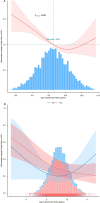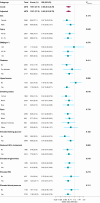Nonlinear relationship between serum Klotho and chronic kidney disease in US adults with metabolic syndrome
- PMID: 39777219
- PMCID: PMC11703749
- DOI: 10.3389/fendo.2024.1409560
Nonlinear relationship between serum Klotho and chronic kidney disease in US adults with metabolic syndrome
Abstract
Background: Current evidence regarding the effects of serum Klotho among patients with metabolic syndrome (MetS) is scarce. This study explored the relationship between serum Klotho levels and the odds of chronic kidney disease (CKD) in middle-aged and older populations with MetS.
Materials and methods: This cross-sectional study analyzed data from 4870 adults aged 40-79 years who participated in the National Health and Nutrition Survey (NHANES) from 2007 to 2016. CKD was identified at urinary albumin to creatinine ratio (UACR) of 30 mg/g or higher and/or an estimated glomerular filtration rate (eGFR) below 60 mL/min/1.73 m2. Measurement of serum Klotho concentration was determined via enzyme-linked immunosorbent assay (ELISA) and subsequently divided into four quartiles (Q1-Q4). The NHANES criteria were followed in calculating the sampling weights. Multivariable logistic regression models were employed to assess the correlation between Klotho and CKD, while generalized linear models with cubic spline functions and smooth curve fitting were utilized to detect any nonlinear relationship. Additionally, subgroup analysis and a range of sensitivity analyzes were conducted.
Results: Results showed that a nonlinear L-shaped relationship existed between serum Klotho levels and CKD risk, with the lowest prevalence observed at 9.63-9.94 pg/mL Klotho concentrations. With a two-segment linear regression model, an inflection point of 9.88 pg/mL was noted. Hypertension status was identified as an interaction mediator (P interaction = 0.006). Sensitivity analysis showed stable results.
Conclusions: A nonlinear L-shaped relationship exists between serum Klotho levels and risks of CKD among middle-aged and older adults with MetS, with the lowest prevalence observed at 9.63 to 9.94 pg/mL Klotho concentrations. Our findings, if replicated, underscore the need to estimate the optimal serum Klotho concentrations and the consequential inverse relationship, thus implying the potential of Klotho as both a serum biomarker and a possible preventive or therapeutic intervention.
Keywords: L-shaped; NHANES; chronic kidney disease; metabolic syndrome; α-Klotho.
Copyright © 2024 Lin and Yang.
Conflict of interest statement
The authors declare that the research was conducted in the absence of any commercial or financial relationships that could be construed as a potential conflict of interest.
Figures





Similar articles
-
Association of serum Klotho with the severity and mortality among adults with cardiovascular-kidney-metabolic syndrome.Lipids Health Dis. 2024 Dec 18;23(1):408. doi: 10.1186/s12944-024-02400-w. Lipids Health Dis. 2024. PMID: 39695774 Free PMC article.
-
Serum klotho is inversely associated with metabolic syndrome in chronic kidney disease: results from the KNOW-CKD study.BMC Nephrol. 2019 Apr 3;20(1):119. doi: 10.1186/s12882-019-1297-y. BMC Nephrol. 2019. PMID: 30943913 Free PMC article.
-
The association between serum soluble Klotho and chronic kidney disease among us adults ages 40 to 79 years: Cross-sectional study.Front Public Health. 2022 Oct 6;10:995314. doi: 10.3389/fpubh.2022.995314. eCollection 2022. Front Public Health. 2022. PMID: 36276390 Free PMC article.
-
Hypertension modifies the association between serum Klotho and chronic kidney disease in US adults with diabetes: a cross-sectional study of the NHANES 2007-2016.Ren Fail. 2025 Dec;47(1):2498089. doi: 10.1080/0886022X.2025.2498089. Epub 2025 May 5. Ren Fail. 2025. PMID: 40324899 Free PMC article.
-
Effects of Klotho in epilepsy: An umbrella review of observational and mendelian randomization studies.Epilepsy Behav. 2025 Mar;164:110231. doi: 10.1016/j.yebeh.2024.110231. Epub 2025 Jan 16. Epilepsy Behav. 2025. PMID: 39823737
References
-
- Grundy SM, Cleeman JI, Daniels SR, Donato KA, Eckel RH, Franklin BA, et al. . Diagnosis and management of the metabolic syndrome: an american heart association/national heart, lung, and blood institute scientific statement. Circulation. (2005) 112:2735–52. doi: 10.1161/CIRCULATIONAHA.105.169404 - DOI - PubMed
MeSH terms
Substances
LinkOut - more resources
Full Text Sources
Medical
Research Materials
Miscellaneous

